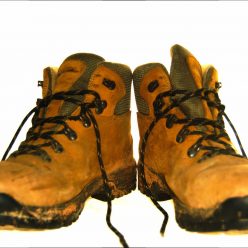When I am walking a long distance path I do not aspire to get lost. I am happy to take my time over the journey but actually getting lost at best means it will take longer and at worst is dangerous. To this end I use multiple navigation techniques:
- Waymarking – that is keeping a watch out for marks made by others that show the correct route of the trail
- Route Map and Guidebook, used for imaging the trail in advance and for checking I am still going the right way when I have not seen a waymark for a while
- GPS with the trail on it to check I am still on the route when I start panicking
- OS maps of the area (1:25,000) and compass for when I know I am off the trail and I want to get back on.
What should be obvious is that following a trail takes effort. However, for 90% of the time waymarking is sufficient. That is following the directions from one waymark I immediately start looking for the next. If the trail is difficult then the next waymark is visible from the present one, if the trail is easy to follow then it can be quite a while between waymarks. Normally when I get the route map out it is to check I have not missed a waymark because I have been following a well-defined trail. Usually, I am panicking.
Walking St Cuthbert’s Way between Wooler and Beal it crosses Weetwood Moor. About two-thirds of the way across it takes a 90-degree turn. However, a clear path runs straight ahead. When I was crossing Weetwood Moor another couple of people walking St Cuthbert’s Way called Chris and Peter were walking about fifty yards behind me. We had got to know each other over the previous days on the route. I missed the waymark for the turn! I started to get suspicious when I went through a gate which was not waymarked (gates normally are) and half way through the next field I checked my GPS and I was clearly off route. At this point, I shouted back to Chris and Peter who were still following me (I was about 150 metres off route).
We together traced our steps to the turn-off and started out again. This time, I let them lead (I was obviously not doing too well this day). The net result was we promptly got off route again by heading across a field instead of staying by the wall. The ground we travelled on was decided tricky and Peter and Chris did not fancy retracing for the second time in the day. Nor actually did I. For the one and only time in walking the route I got out the OS maps. I was able to place us and also able to point out that across the wall at the other side of the field to the gate we were at was a quarry. Peter did not believe me and went to check finding out that it was indeed the case. I was, however, also able to point out it might be possible to walk around the quarry by crossing the wall further on. This is what we did though we ended up hacking our way through bracken and a steep descent down to the road across a field. We came out back on the path and the view gave a clear indication of where we were to walk. When we were past this we were on territory where I had walked doing the Northumberland Costal Path.
Intriguingly others also walking the way got lost in much the same way at exactly the same point so we were not complete dunces. However, I find getting lost was instructive.
Firstly, being with people when lost is far better than being lost and alone. When making decisions on how to get back, groups tend to balance each other out. However, just because someone is in front of you on the same journey does not mean they are on the right track!
Secondly, both getting lost was because we were not careful enough. I should have been looking out for the turning in the first case and in the second we should have spotted that the path ran next to the wall once we were through the gate. In other words checking waymarks against maps and maps against waymarks is a good idea.
Thirdly there are two ways to get back on the route: retracing or detouring. Usually, preference is for retracing and the bias should always be for that. Detouring frequently takes you across tougher ground and can lead you into danger. However, there can be good reasons to detour such as when the ground already covered is difficult to cover. You are balancing possible future danger against known past danger. Again the ability to consider this with others is important.
I am careful of what I am drawing, but I am aware that I am in uncharted area spiritually. I need to find a way across and the route back is actuall to a dead end. I initially thought that I should look for those who may know something of the territory, maybe I still should but I am now aware they may be heading in the wrong direction and retracing is expensive. I do, however, know that I will value companions who may or may not equally be seeking routes across the terrain. The ability to seek a way forward together seems to me a great blessing.


It sounds as though you are going over hard terrain. You’re in my prayers. And thanks for the reassurance that I’m not the only one who has difficulty with finding the way!
The going may be tough but I am moving albeit slowly, which I was not six months ago and for that I am grateful.